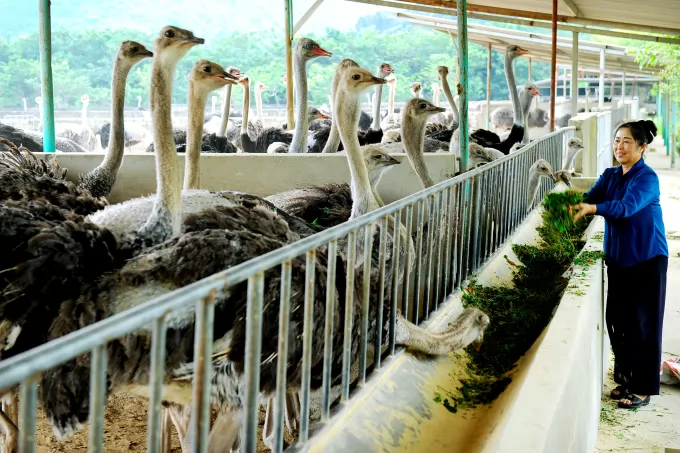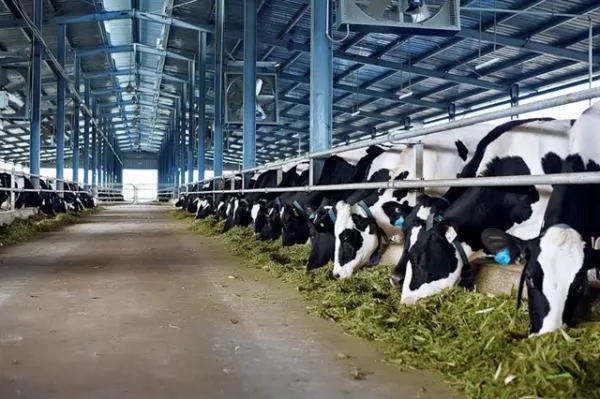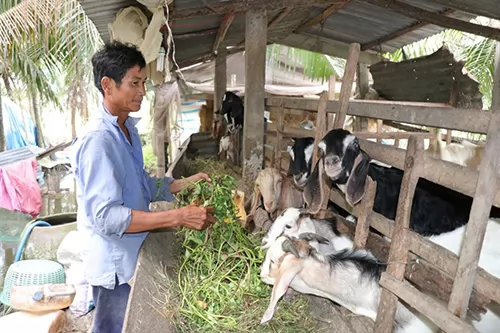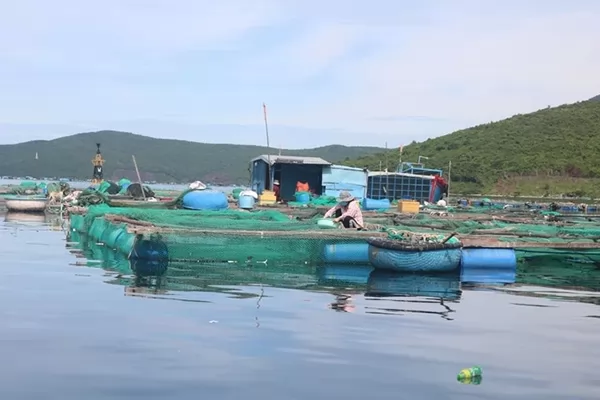U70 female farmer earns billions by raising ostriches

Ms. Binh owns an ostrich farm worth tens of billions of dong. Image: NVCC
Hai DuongEach year, the 10-hectare farm with 600 ostriches brings Ms. Nguyen Thi Binh billions of dong from providing breeds, eggs, meat, sausages and sausages.
Ms. Nguyen Thi Binh, 61 years old (Minh Tan commune, Kinh Mon town) is one of two faces in Hai Duong province honored by the Central Vietnam Farmers' Union as "Outstanding Vietnamese Farmer" in 2023.
Born into a farming family, at the age of 18, Ms. Binh joined the armed police and then served as a worker at the Hoang Thach cement factory. Nurturing the desire to get rich, in 1994, Mrs. Binh quit her job to join her husband in opening a construction materials business. Thanks to hard work and luck, she and her husband also have a living.
At the end of 2005, Ms. Binh went to an agricultural fair in Hai Phong and was given documents introducing the ostrich farming model. Seeing large, wild animals raised like chickens and ducks, Mrs. Binh was very curious and came up with the idea to follow suit. However, four years later, Mrs. Binh was determined to change her family's production model to raising ostriches.
After many days of visiting Thuy Phuong Poultry Research Center (Hanoi) to visit and learn about breeding techniques, Ms. Binh mobilized her family's capital and borrowed more to invest 5 billion VND to build a farm with 60 million VND. The bird is more than three months old.
In the early days, Mrs. Binh faced very strong opposition from her husband. He believes that investing billions in raising wild animals originating in Africa is too risky. "I tried every way to stop her, but I couldn't overcome her will," recalled Mr. Bui Van Hien, Ms. Binh's husband.
Raising ostriches is not easy. Farm workers are not familiar with how to handle and care for them, so they often get kicked by the ostriches or make them run wild, leading to broken legs. During Tet 2010, the sound of New Year's Eve fireworks even scared the ostriches, jumping out of their cages and running everywhere. The whole family and farm workers had to split up to find and bring them back to the barn.
Persevering in conquering, Mrs. Binh and the farm workers gradually tamed the giant birds. "Now, whenever we see the green shirt of a worker, the whole herd raises its head to look for food and is no longer aggressive or runs away like before," said Vu Thi Huyen, who has been with the farm for more than 10 years.
The farm currently has about 200 ostriches of reproductive age, 400 commercial ostriches, raised in 20 cages with an area of about 200 m2 each.
To give the ostriches space to run around, Mrs. Binh arranged 30 ostriches in a lot, spread the floor with yellow sand, and had a feeding trough in front of the cage. Every day, workers must clean the cage cleanly, making sure the ostriches do not accidentally eat foreign objects.
Although of wild origin, ostriches are easy to raise, adapt well to the climate in the North, have few diseases, and can eat many types of weeds and bran made from rice flour and corn. To save costs and protect the environment, Ms. Binh built a closed farming model. Ostrich manure is used to fertilize plants, fish and duckweed, and then the plants and duckweed become food for them. Every day, an ostrich eats 1,5 kg of flour, 1 kg of grass and drinks 4 liters of water. During the breeding season, it will eat more.

Ostrich breeds are sold for 1,5 million VND each. Image: Le Tan
Not only providing breeds, eggs, and meat, Ms. Binh also processes ostrich sausage and sausage products into products that meet OCOP 4 quality standards certification. She even opened her own restaurant in Hai Duong City. to introduce ostrich dishes.
Mrs. Binh always works on the farm until late at night to check each batch of cages and egg incubators. “I have maintained this habit since the first days of setting up camp. With high-value livestock, a small mistake can cause hundreds of millions, even billions of dong to be lost overnight," she explained.
At the same time that Mrs. Binh started to build a farm, in Hai Duong there were also people raising ostriches but went bankrupt. "I went to the place to ask questions and gain experience for myself to avoid falling into their footsteps," the farm owner said.
In 2020, Ms. Binh's ostrich farm profited more than 1,3 billion VND, in 2021 and 2022 it profited more than 2 billion VND. The farm, worth tens of billions of dong, is also a place to create jobs for dozens of workers with salaries of 6-15 million dong.
"My wish is to create a livestock breed center with high economic value for people to come learn and import breeds at low prices," Ms. Binh said, saying that in the near future she will expand the scale. camp up to 2.000 children.
Mr. Hoang Minh Coi, Chairman of the Kinh Mon Town Farmers' Association, commented that Ms. Binh is "an excellent farmer, with the spirit of daring to think and daring to do." In addition to being good at economics, she also actively participates in charity, building new rural areas and local activities.
Le Tan
Maybe you are interested

Tech important to promoting dairy industry
HÀ NỘI — Việt Nam has significant room to promote the dairy industry with the application of technology in farming and processing to establish a value chain, given the rising demand for dairy products in the domestic and global markets...

Goat breeding brings high incomes to farmers in Bến Tre
BẾN TRE – Breeding goats has helped many farmers in the Cửu Long (Mekong) Delta province of Bến Tre escape poverty and have a stable income as the animal is easy to breed and does not require large investment.

Solutions for sustainable growth of lobster farming
(VAN) In an interview with Vietnam Agriculture News, Tran Dinh Luan, director of the Directorate of Fisheries, proposed solutions for developing sustainable lobster farming in the South Central areas.





